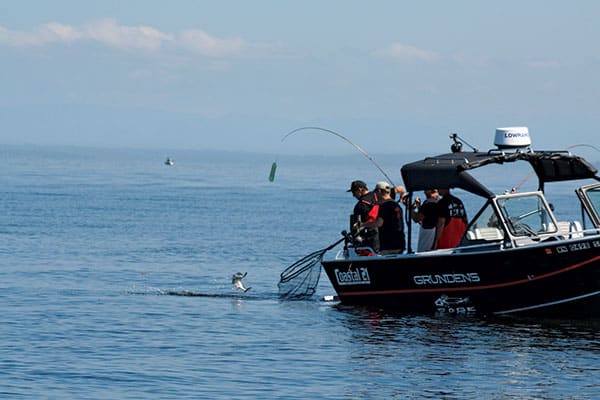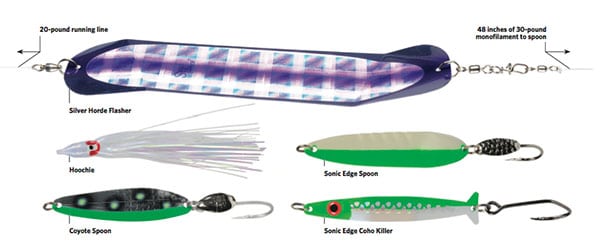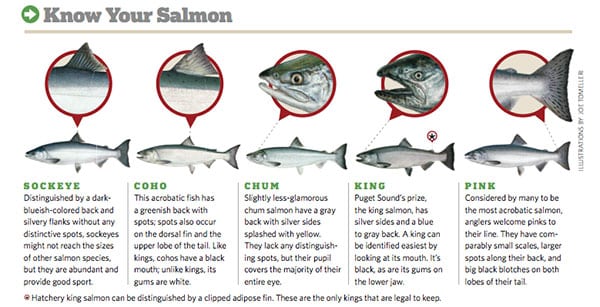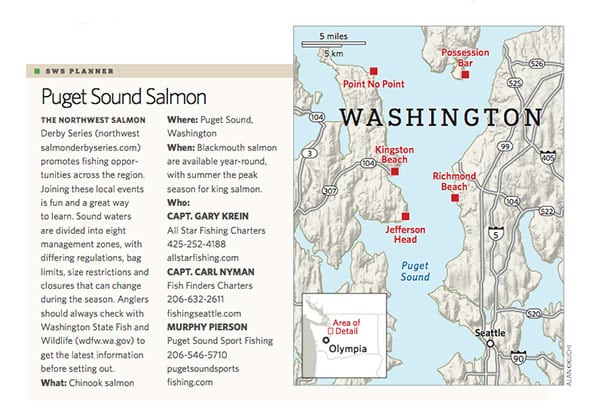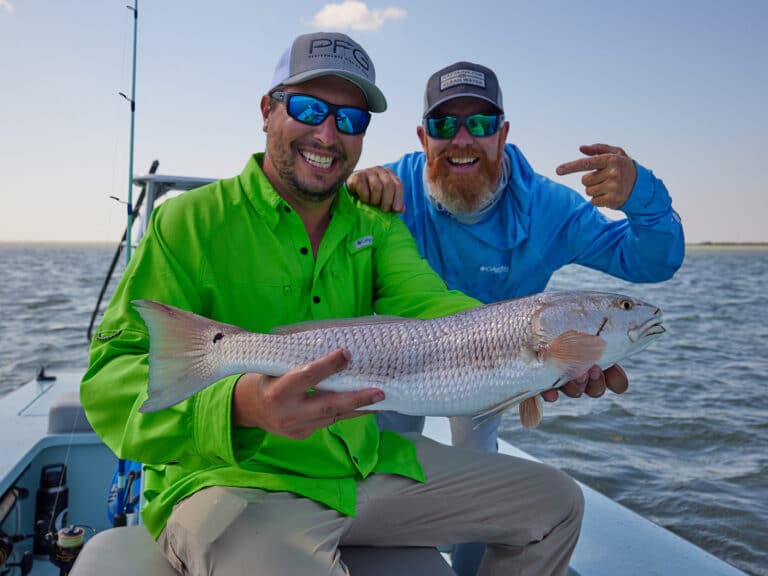I stopped the descent of the electric downrigger at 45 feet,** **then turned the reel handle until the line drew tight and the long salmon rod bent into a rainbowlike arch. Content that my flasher and spoon were in the zone, I leaned back and took in our surroundings.
We certainly weren’t alone off some remote Alaskan island. A dozen or so boats trolled nearby as a car-laden Washington State Ferry sliced a swath through our conga line of fishing vessels. One only had to peer through the early-morning haze to recognize the iconic skyline of downtown Seattle in the distance. Even though the area boasts some 3 million residents, I remained confident that the king salmon we desired would find us — or vice versa.
In 20 minutes’ time, my confidence was rewarded. It began with a few light “tap-taps” on the portside rod, followed by an almost imperceptible increase in load. As soon as Mat Jackson lifted the rod from its holder, the line popped free of the downrigger clip and melted off the spool. A few head shakes, and the fight began in earnest. After a spirited battle, a fat, 19-pound king salmon hit the deck — an excellent first fish of the day, and caught almost within sight of the launch ramp.
Many Happy Returns
To help ensure a robust, year-round salmon fishery across the region, hatcheries between the Canadian border and Olympia, Washington, produce some 30 million fish annually. According to Tony Floor — who spent 30 years with the Washington Department of Fish and Wildlife and is currently director of fishing affairs for the Northwest Marine Trade Association — about 90 percent of those fish hang a right and head north to Alaska. They return in the third, fourth or even fifth year of their lives as sexually mature king (or chinook) salmon, driven by spawning instincts to find their river of origin. About 10 percent of these fish stay close to home, and anglers enjoy catching them year-round as blackmouth salmon — the name for any sexually immature king salmon, regardless of size or age.
Salmon Strategies
A good number of these hatchery fish — along with protected wild kings and schools of silver salmon — swim through the waters of Puget Sound. To help increase our odds of running into some during our midsummer trip, we joined forces with Capt. Gary Krein of All Star Fishing Charters. Krein has been fishing these waters for decades, and probably knows as much about salmon behavior as the fish themselves.
Certain areas of the sound tend to concentrate salmon on a regular basis. Well-known spots like Jefferson Head, Kingston and Richmond Beach near Seattle, or Possession Bar and Point No Point farther north, are good places to start. Krein emphasizes the importance of the why just as much as the where. Just like all predators, count on salmon to follow the food.
Consistent action depends on where the bait is, or where it’s going to be. Pay attention to echo sounders for bait schools and, equally important, keep a lookout for signs above the water, which often reveal the whereabouts of salmon.
We noticed Krein’s face light up when we came upon dozens, if not hundreds, of birds rafted up in a tight group. They weren’t diving; they were just hanging out. “These guys just know where the bait is going to show up,” says Krein. On this afternoon, boat after boat left the area due to slow fishing, however, we stuck it out based on the presence of birds. Sure enough, we ended the day with the bite all to ourselves.
Hauling Hardware
While trolling rigged dead herring**** is a great technique much of the year, invasions of spiny dogfish make baitfishing impractical during summer. To minimize wasted time hooking and unhooking these diminutive sharks, anglers troll a variety of artificial lures designed to imitate the herring and candlefish that draw salmon to these waters.
Single-hook metal spoons trolled about 48 inches behind a large 10- to 12-inch flasher is perhaps the most popular tactic in these waters. Flashers swing a 180-degree arc as they travel through the water. They reflect light and create underwater
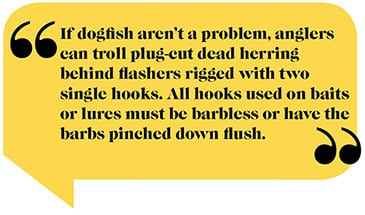
vibrations that draw attention to trailing spoons. A trolling speed of about 21/2 mph should produce optimal action in the rig. If you’re seeing fish on the sonar without getting bit, or notice other boats around you hooking up, speed up or slow down slightly.
When salmon are feeding on herring, anglers often turn to popular 31/2- or 4-inch Coyote or Sonic Edge spoons in green white/silver patterns. Long and slender Coho Killer Spoons in variations of green-and-white or an all-white pattern known as “white lightning” are excellent choices when kings are feeding on candlefish or sand lance. A variety of different plastic hoochie lures, which look like small squid, can be fished behind a flasher with success. These are usually rigged with twin single hooks. If the dogfish aren’t too thick, you can increase the attraction of your hoochies by adding a 1- or 2-inch strip of herring to the forward hook.
Salmon hooks must be barbless, and only hatchery kings — indicated by a clipped adipose fin — can be kept.
Landing big king salmon requires practice and patience. Salmon love to jump and shake their head, and they have a soft mouth. Add barbless hooks to this combination, and it’s easy to see why so many come unglued. “Stay snug to the fish at all times, but don’t reel when he shakes his head,” advises Floor. “It’s like a boxing match. When you’re getting punched, you wait. When you’re not getting punched, you go for it.”
Whether you need to slow down, or even clear the other lines to give chase to a fish, depends on several factors. The size of the fish, how much line it’s taking and the number of boats nearby should dictate your fighting style. “If you need to go after the fish, don’t hesitate,” says Floor.
Salmon always seem to save a sucker punch or two for the end, which makes netting these fish a challenge in itself. Anglers should lead the fish, on or just below the surface, toward the net, and the netter should keep the net out of the water with his hands set far apart until the last moment. It’s also critical to secure the bag with your forward hand so you can control the net and keep it from getting caught on anything. Release the bag just as you slide the net into the water, in one fluid motion.


